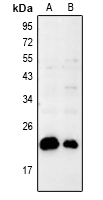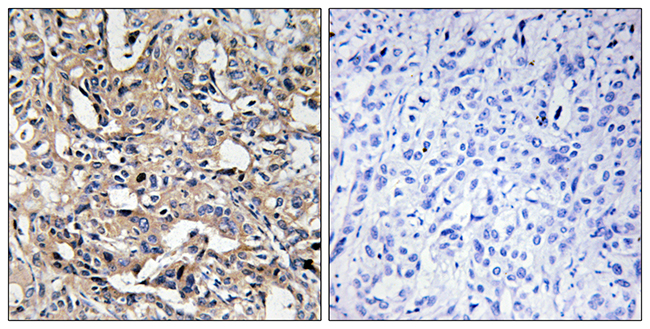
IHC-P analysis of formalin fixed human lung cancer tissue section using GTX56246 Bax antibody. Antigen retrieval : Heat mediated antigen retrieval with sodium citrate buffer (pH 6.0)
Bax antibody
GTX56246
ApplicationsWestern Blot, ImmunoHistoChemistry, ImmunoHistoChemistry Paraffin
Product group Antibodies
TargetBAX
Overview
- SupplierGeneTex
- Product NameBax antibody
- Delivery Days Customer9
- Application Supplier NoteWB: 1:500 - 1:1000. IHC-P: 1:100 - 1:200. *Optimal dilutions/concentrations should be determined by the researcher.Not tested in other applications.
- ApplicationsWestern Blot, ImmunoHistoChemistry, ImmunoHistoChemistry Paraffin
- CertificationResearch Use Only
- ClonalityPolyclonal
- ConjugateUnconjugated
- Gene ID581
- Target nameBAX
- Target descriptionBCL2 associated X, apoptosis regulator
- Target synonymsapoptosis regulator BAX; Baxdelta2G9; Baxdelta2G9omega; Baxdelta2omega; BCL2 associated X protein; BCL2-associated X protein omega; BCL2L4; bcl2-L-4; bcl-2-like protein 4
- HostRabbit
- IsotypeIgG
- Protein IDQ07812
- Protein NameApoptosis regulator BAX
- Scientific DescriptionThe protein encoded by this gene belongs to the BCL2 protein family. BCL2 family members form hetero- or homodimers and act as anti- or pro-apoptotic regulators that are involved in a wide variety of cellular activities. This protein forms a heterodimer with BCL2, and functions as an apoptotic activator. This protein is reported to interact with, and increase the opening of, the mitochondrial voltage-dependent anion channel (VDAC), which leads to the loss in membrane potential and the release of cytochrome c. The expression of this gene is regulated by the tumor suppressor P53 and has been shown to be involved in P53-mediated apoptosis. Multiple alternatively spliced transcript variants, which encode different isoforms, have been reported for this gene. [provided by RefSeq, Jul 2008]
- Storage Instruction-20°C or -80°C,2°C to 8°C
- UNSPSC12352203
References
- Rosmarinic acid treatment protects against lethal H1N1 virus-mediated inflammation and lung injury by promoting activation of the h-PGDS-PGD(2)-HO-1 signal axis.Read more
- Silencing of the lncRNA H19 enhances sensitivity to X-ray and carbon-ions through the miR-130a-3p /WNK3 signaling axis in NSCLC cells. Zhao X et al., 2021 Dec 4, Cancer Cell IntRead more
- Effects of Oxymatrine on the Proliferation and Apoptosis of Human Hepatoma Carcinoma Cells. Liu Y et al., 2016 Jun, Technol Cancer Res TreatRead more







![IHC-P analysis of human breast carcinoma tissue using GTX34053 Bax antibody [1C1]. Dilution : 1:200](https://www.genetex.com/upload/website/prouct_img/normal/GTX34053/GTX34053_20200622_IHC-P_272_w_23060801_135.webp)
![FACS analysis of Jurkat cells using GTX34420 Bax antibody [SPM336]. Blue : Primary antibody Red : Isotype control](https://www.genetex.com/upload/website/prouct_img/normal/GTX34420/GTX34420_20200115_FACS_1473_w_23060801_417.webp)
![FACS analysis of Jurkat cells using GTX34421 Bax antibody [BAX/962]. Blue : Primary antibody Red : Isotype control](https://www.genetex.com/upload/website/prouct_img/normal/GTX34421/GTX34421_20200115_FACS_1477_w_23060801_735.webp)
![FACS analysis of Jurkat cells using GTX34422 Bax antibody [2D2]. Blue : Blank Red : Isotype control Orange : Primary antibody](https://www.genetex.com/upload/website/prouct_img/normal/GTX34422/GTX34422_20200115_FACS_1482_w_23060801_563.webp)